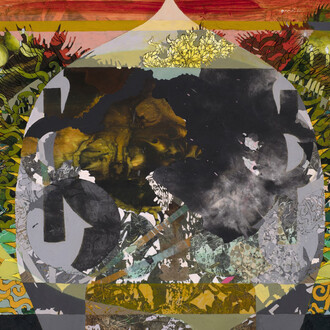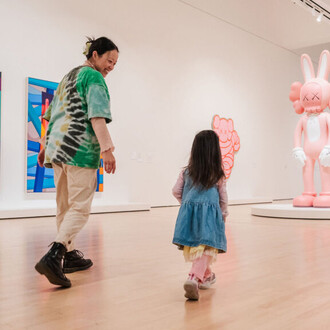Each of Hunt Rettig’s assemblages is animated by a particular cadence, the baseline for which is a sublime furling and unfurling of curvilinear forms. To achieve these original constructions, Rettig brings together everyday materials—such as polyester film, synthetic rubber, plastic, and acrylic paints—in unexpected ways. Central to his practice is emphatic experimentation that spurs him to look beyond and aim high, as the title of one 2019 assemblage declares. In that work, Aim High II, a soaring, almost birdlike form bends, twirls, and folds back on itself. Its fractal geometry is amplified by its golden palette, which shifts from deep orange to bright yellow—a nod, perhaps, to our most brilliant celestial neighbor.
Rettig’s process and priorities as an artist echo his larger worldview. He notes that what we know about the universe is only a fraction of what there is to know. It is in our awareness of our not knowing, however, that we can start to see that anything is possible: “4-D. Entire planes of infinite reality existing in the narrows. Yes, Santa Claus, fairies, mechanical elves. Ghosts. 5-D. 9-D.” The endless array of possibilities is a galvanizing force for creation. With the limits undefined, what we can achieve or reach is only obstructed by narratives that we alone author.
A sense of limitlessness can be gleaned just by looking out into the night sky, beyond our own solar system and into the deep, dark vault that glitters with galaxies spinning lightyears away. This telescoping outward is mirrored by an internal drilling down, first to the cellular, then the atomic and subatomic levels. Infinity, it seems, works in both directions. Rettig’s compositions capture the kinetic forms we find on these journeys. His structures are natural but also supernatural, primal but futuristic. They coalesce in complex relationships, blooming and collapsing in cycles that drift and swell or contract over time. Yak Karta Bridge (2019) offers a distillation of this mesmerizing dynamic, its simplified composition embodying the mechanics of a wave, the movement of a wing, the cross-section of a shell, and more. The form is of nature, but it is also a building block from which everything expands out and, in theory, toward which it boomerangs back.
Where the works terminate—their natural target, in a sense—is an obvious question because, as Rettig observes, “the entirety of our lives points to an end.” This end, however, is beyond our grasp; what we are left with instead is a realm of unknowns and of magic. “With infinity everywhere and so little understanding, is it any wonder that there is so much wonder?”
Hunt Rettig was born in 1968, in El Paso, Texas, and resides in Aspen, Colorado. He received a BA from Babson College in 1990. Rettig has exhibited extensively across the United States and has had work acquired into prominent collections both in North America and abroad.
















